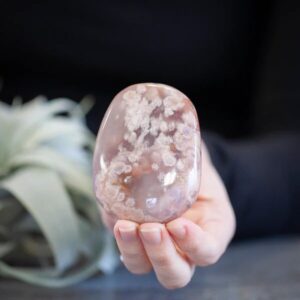
Introduction
There are several mesmerising minerals in the gemstone world, each with its own narrative to tell. Flower Agate is one gemstone that has piqued the interest of both collectors and enthusiasts. Flower Agate stands out as a beautiful work of nature’s art, with its exquisite flower designs and enticing colours. In this in-depth examination, we will look at the geological origins, features, formations, and importance of this fascinating mineral.
Geological Origins
Flower Agate, officially classed as a chalcedony variation, is a member of the vast quartz mineral family. Chalcedony is a microcrystalline form of quartz distinguished by its fine-grained structure and waxy lustre. Flower Agate is distinguished from other chalcedony kinds by its distinctive interior patterns like blossoming flowers, which give it an airy and appealing look.
The geological processes that create Flower Agate are as interesting as the gemstone itself. Flower Agate is thought to have formed as a result of volcanic activity, in which silica-rich fluids permeated voids within host rocks such as basalt. Over time, these fluids crystallise, resulting in complex formations within the voids. The abundance of impurities and mineral inclusions contributes to Flower Agate’s unique colours and patterns.
Description and Appearance
One of Flower Agate’s most outstanding aspects is its gorgeous interior patterns, which are very similar to blooming flowers. These patterns usually appear as dendritic structures or plumes that are elaborately intertwined into the transparent chalcedony matrix. Flower Agate’s colours span from subtle pastels to vivid hues, with pink, peach, white, and green being particularly frequent. The combination of colours and patterns within each specimen creates a sense of depth and dimension, adding to its attraction.
Flower Agate, in addition to its visual appeal, has favourable physical qualities that make it desirable as a gemstone. Its Mohs hardness ranges from 6.5 to 7, making it excellent for usage in a variety of jewellery and lapidary arts. Flower Agate’s relatively high resilience means it can resist the rigours of daily usage, making it a popular option for gemstone fans looking for both beauty and endurance.
Formation and Occurrence
Flower Agate is most commonly found in areas with a history of volcanic activity, where the geological conditions required for its creation exist. Madagascar, China, and the United States are notable suppliers of Flower Agate, with each producing specimens with distinct colours and patterns.
Madagascar is well-known for its broad variety of gemstones, but it is especially known for creating high-quality Flower Agate specimens. The deposits in Madagascar sometimes produce examples with vibrant pink and peach hues, covered with exquisite flower designs that equal the splendour of a botanical garden. Collectors and lapidary artists value these examples for their outstanding beauty and workmanship.
Flower Agate is most often found in Guangdong Province, China, and is recognised for its delicate pastel colours and beautiful dendritic structures. The examples from China have a tranquil grace evocative of cherry blossoms in full bloom. While not as well known as Madagascar examples, Chinese Flower Agate has a devoted following among gemstone enthusiasts.
Flower Agate has been discovered in various regions in the United States, including Oregon and Washington. Although less frequent than other sources, American Flower Agate has its own distinct beauty, with specimens varying in colour from gentle whites to bright greens. These examples are prized by local collectors and lapidary aficionados for their unique beauty and historical relevance.
Significance and uses
Beyond its visual appeal, Flower Agate has symbolic meaning in many civilizations and traditions. Flower Agate is thought to represent growth, rejuvenation, and abundance in metaphysical circles, making it an attractive option for spiritual healing and meditation activities. It is frequently connected with the heart chakra, which promotes peace, compassion, and emotional balance.
Flower Agate is highly valued in the jewellery and creative arts industries for its flexibility and beauty. Its exquisite patterns and calming colours make it an excellent material for making striking items like pendants, earrings, and rings. Flower Agate is also used by lapidary artisans to create beautiful artefacts like as carvings and sculptures, where its natural beauty can be fully appreciated.
Furthermore, Flower Agate demonstrates nature’s ongoing inventiveness and brilliance. Its creation over millions of years demonstrates the incredible durability and beauty of the Earth’s geological heritage. As a result, Flower Agate acts as a concrete reminder of the interdependence of geology, art, and culture, bridging the gap between the natural world and human creation.
Conclusion
Finally, Flower Agate reflects the natural world’s enchanting beauty and mystery. Flower Agate, with its geological roots in volcanic settings and gorgeous formations of blossoming flowers, continues to fascinate the imaginations of collectors, enthusiasts, and spiritual searchers alike. As we continue to uncover the mysteries of this enchanted diamond, we develop a greater appreciation for the wonderful diversity of Earth’s geological riches and the enduring fascination of nature’s workmanship.










